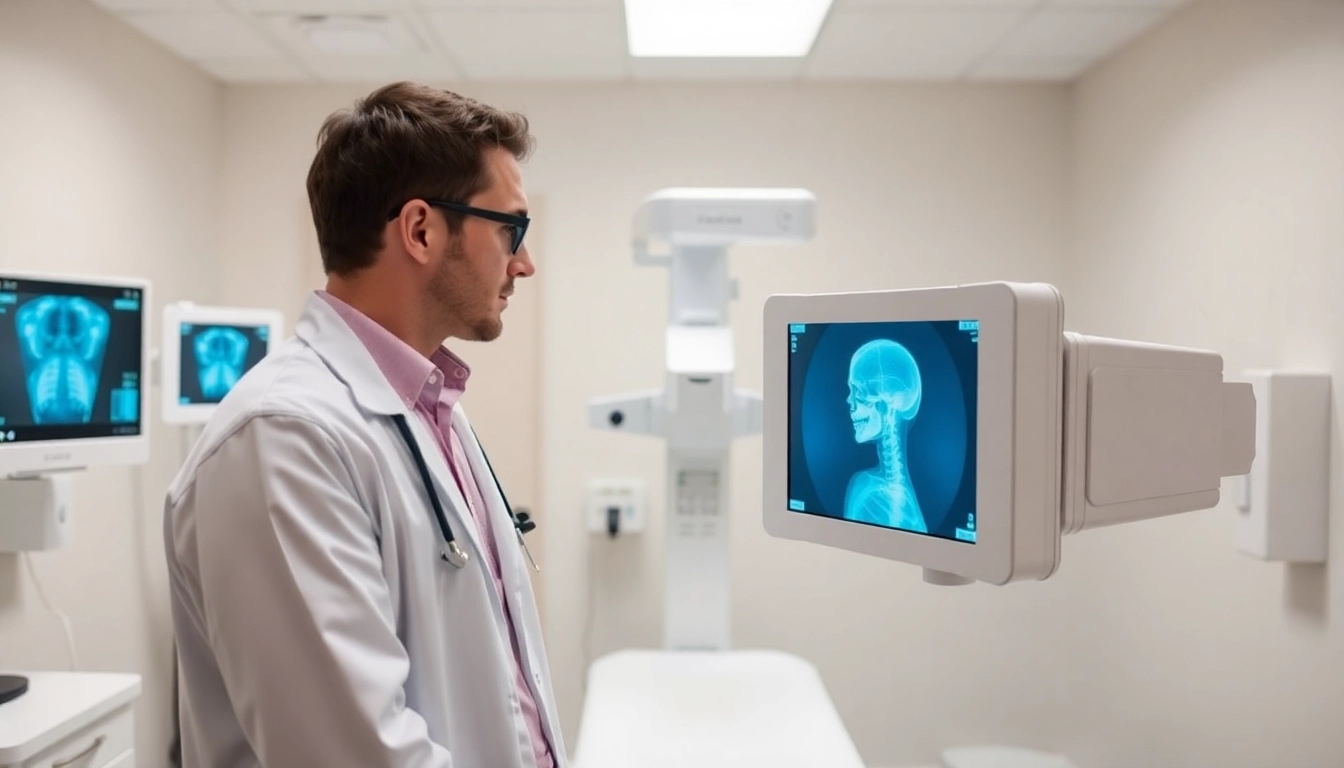Understanding Digital X-Ray Equipment
What is Digital X-Ray Technology?
Digital X-ray technology has revolutionized the field of medical imaging by offering a method for capturing and storing images digitally, rather than on traditional film. This transition from analog to digital has been driven by the need for more efficient, precise, and clearer imaging processes. With digital X-rays, images are captured via electronic sensors that convert the X-ray energy into digital images that can be easily viewed, enhanced, and stored electronically. This technology not only improves the diagnostic capabilities of radiologists but also enhances the overall patient experience by minimizing exposure to radiation and streamlining the imaging process.
Today, digital X-ray equipment is prevalent in both hospital and private practice settings, making it crucial for medical professionals to understand the distinctions between new and refurbished systems. For those interested in learning more about new vs. refurbished digital X-ray equipment, this guide is designed to provide insights into both options, helping practitioners make informed decisions.
Key Components of Digital X-Ray Equipment
The primary components of digital X-ray equipment include the X-ray generator, the digital detector, and the workstation for image processing. The X-ray generator is responsible for producing the X-rays, while the digital detector captures the X-rays that pass through the patient’s body and converts them into digital signals. These signals are then processed into images that can be displayed on a computer monitor. Additionally, specialized software enhances these images for better diagnostics, allowing healthcare professionals to manipulate and analyze them with great precision.
Advantages of Digital Over Analog Equipment
There are numerous advantages to using digital X-ray equipment as opposed to traditional analog systems. Key benefits include:
- Reduced Radiation Exposure: Digital systems require less radiation to produce high-quality images, thereby reducing patient exposure significantly.
- Immediate Results: With digital imaging, results are available almost instantly, facilitating quicker diagnosis and treatment decisions.
- Enhanced Image Quality: Digital images can be easily adjusted for contrast and brightness, improving diagnostic accuracy.
- Storage and Sharing: Digital images can be stored electronically and shared easily among healthcare providers, enhancing collaboration and efficiency.
- Cost-Effective Over Time: Although the initial investment is higher, the reduction in film and processing costs, along with the elimination of physical storage needs, makes digital systems more cost-effective in the long run.
New Digital X-Ray Equipment: Pros and Cons
Features of Newly Manufactured Equipment
Investing in newly manufactured digital X-ray equipment comes with an array of features designed to meet the latest standards in medical imaging. These features typically include advanced imaging technologies, sophisticated software for image analysis, and higher efficiency in imaging workflows. Newly produced devices often comply with the newest safety regulations, providing peace of mind to operators.
Moreover, new equipment may offer high-resolution imaging capabilities and integration with electronic health record (EHR) systems, allowing for seamless data management and improved patient care. Additionally, manufacturers may incorporate features that enhance ease of use—such as touchscreen interfaces and automated calibration procedures—to streamline the imaging process.
Cost Considerations for New X-Ray Units
While new digital X-ray equipment offers the latest technology, it often comes with a significant price tag. Costs can vary widely based on the equipment type, features, and brand. For instance, a complete digital X-ray system can range from $50,000 to over $150,000, depending on specifications. Beyond the purchase price, healthcare facilities must also consider additional costs such as installation, software upgrades, training for staff, and routine maintenance.
However, financing options, leasing agreements, and potential government incentives may help alleviate the financial burden associated with acquiring new equipment. Facilities should conduct a thorough cost-benefit analysis to understand the long-term implications of such an investment.
Warranties and Support for New Equipment
Purchasing new digital X-ray equipment typically includes comprehensive warranties and support from the manufacturer. Warranties may cover parts and labor for a specific timeframe, ensuring that any issues can be addressed promptly without incurring additional costs. Additionally, manufacturers often provide training and support resources—such as manuals, online tutorials, and customer service hotlines—to facilitate the effective use of the equipment.
It’s essential for healthcare providers to review the warranty terms carefully, as support during the warranty period can significantly influence the operational efficiency of the imaging equipment.
Refurbished Digital X-Ray Equipment: A Smart Alternative?
What to Know About Refurbished Units
Refurbished digital X-ray equipment refers to previously owned devices that have been returned to the manufacturer or a certified refurbisher for restoration to full operational condition. This restoration process may include repairs, software updates, and cosmetic refurbishments to ensure the equipment is functioning like new. Though refurbished equipment often comes at a reduced price compared to new units, it is crucial for buyers to understand the refurbishment process and any warranty coverage available.
Certified refurbishers typically conduct thorough testing before reselling the equipment, which can provide buyers with additional confidence in their purchase. Buyers should always request documentation regarding the refurbishment process and warranties available, as these factors can vary significantly between providers.
Benefits of Choosing Refurbished Over New
Choosing refurbished digital X-ray equipment can deliver several benefits, especially for smaller medical practices or those with budget constraints:
- Cost Savings: Refurbished units can offer substantial initial savings—often ranging between 30% to 60% less than new devices—allowing practices to allocate resources to other essential areas.
- Quality Assurance: Many refurbished systems undergo rigorous testing and come with warranties, ensuring that they meet quality standards for patient care.
- Reduced Depreciation: New equipment experiences rapid depreciation in its value, while refurbished units retain a more stable price point.
- Access to High-Quality Technology: Practices can leverage high-end technology at a fraction of the cost, enabling them to compete effectively in a modern healthcare environment.
Common Misconceptions about Refurbished X-Ray Equipment
Despite the benefits of refurbished digital X-ray equipment, there are common misconceptions that may deter potential buyers:
- “Refurbished Means Defective”: Many believe that refurbished equipment is faulty. However, certified refurbishing processes ensure that these devices are fully operational and often tested to meet or exceed original manufacturer specifications.
- “Limited Lifespan”: Buyers may assume that refurbished units have a shorter operational lifespan. When properly maintained, refurbished devices can perform reliably for many years.
- “Lack of Support”: Some assume that refurbished equipment does not come with support or warranties, but many certified refurbishers offer robust support services similar to those for new equipment.
Making the Right Choice: New vs. Refurbished
Factors to Consider When Choosing
When faced with the decision of whether to purchase new or refurbished digital X-ray equipment, several factors should be taken into account:
- Budget: Understand the financial constraints of your practice and how they will impact the choice between new and refurbished options. Consider not just the purchase price, but overall cost of ownership, including maintenance, software updates, and operational costs.
- Volume of Use: Assess the expected usage of the X-ray unit. High-volume practices may benefit from the durability and ongoing support of new equipment, while lower volume may find refurbished options more cost-effective.
- Technology Needs: Evaluate the technological requirements of your practice, including specific features necessary for your diagnostic capabilities. If advanced features are not a priority, a refurbished unit may suffice.
- Space and Layout: Consider the physical space available for the equipment. Depending on the models, new and refurbished systems may have different spatial requirements.
How to Assess Quality and Reliability
Regardless of whether a practice opts for new or refurbished digital X-ray equipment, assessing quality and reliability remains paramount. Here are key strategies for evaluation:
- Research Manufacturers: Investigate the reputation of the equipment manufacturers, focusing on their history of reliability and customer support. Look for reviews, case studies, and feedback from other healthcare providers.
- Certification and Compliance: Ensure that the equipment meets current safety standards and compliance regulations, whether it’s new or refurbished. Certification from recognized organizations can enhance trust in the quality of the equipment.
- Inspect Refurbished Units: When considering refurbished options, inspect the unit for signs of wear and tear, and request documentation of refurbishing processes and warranties before making a purchase decision.
- Seek Professional Guidance: Consult with technicians or imaging specialists who can provide insights into the strengths and potential weaknesses of specific models and manufacturers.
Cost-Benefit Analysis for Medical Practices
Conducting a thorough cost-benefit analysis is crucial before committing to either new or refurbished digital X-ray equipment. This involves:
- Initial Costs: Compare the acquisition costs of new versus refurbished units, factoring in installation and training expenses.
- Long-Term Savings: Analyze the potential savings associated with maintenance, software updates, and operational efficiencies.
- Patient Outcomes: Consider how each option may impact patient care and outcomes, weighing the quality of imaging and diagnosis.
- Financial Flexibility: Reflect on how the choice will affect the practice’s overall financial health and ability to invest in future technology.
Conclusion: The Future of Digital X-Ray Equipment
Emerging Trends in Medical Imaging Technology
The landscape of digital X-ray equipment continues to evolve. Emerging trends include advancements in artificial intelligence (AI) in imaging analysis, portable X-ray systems for bedside imaging, and integration with big data to enhance diagnostic capabilities. Practices that stay updated on these trends will be better positioned to make technological investments that align with their long-term strategic goals.
Final Thoughts on New vs. Refurbished Choices
The choice between new and refurbished digital X-ray equipment ultimately depends on the specific needs and circumstances of each medical practice. By understanding the pros and cons of each option, medical professionals can ensure they make informed decisions that enhance both operational efficiency and patient care.
Resources for Further Research
To delve deeper into the specifics of new vs. refurbished digital X-ray equipment, healthcare providers can access industry publications, manufacturer websites, and professional imaging associations, which often contain valuable resources and tools for comparison. Engaging in consultations with equipment specialists can yield tailored insights that address particular practice needs.



